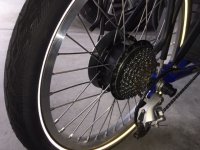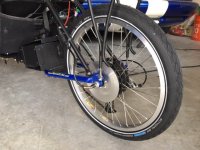"Pass this on to your engineering friend (who is he? I may have done business with him)...Its simple physics BTW...just about any engineer worth their salt can figure this out."
Done and done.
IDK, have you worked for any company called GE Boat? How about Raytheon? Washingtog Group International? Holtec? Aecom? I am sure there is more: He has taught a few courses in engineering and written a ton of papers. Runs a lil company called "Beckersville Steam Engineering" where we spend alot of time on powerplant stuff and rich guys boats. Absolutely a heat expert, He is my Father. He has had his hand in over 1000 nuke, coal hydro, and gas plants... Sent all over the world since I was a kid. Has been
INSIDE just about every nuke/coal/oil/gas plant in the east coast.. He is the go to for heat transfer. He is my father. Question like this is what he spent his entire career on.
He sees certain materials chosen.. like copper for tube fins in boilers.. vs steel... and can quantify everything easily, unlike me. I am going to set up an account for him and have him post here so we get it right. He saw this question asked before I even got itout and he told me he runs into this all the time, some young engineer specs copper for a boiler tube thinking it would be better when steel would do.... Then he comes in when the plant has problems for him to figure out.
Yes, and we got into the fin efficiency, of our situation here.. he explained me that this transfer efficiency is very relevant here, a aluminum disk makes little difference to the steel, and the fin equations can ( and will, when he gets here).. easily show this. Pantyhose wrapped and water splashed on the hub would cool much better (UNTIL the water is gone, then you have an insulator, lol.... .)
Effectiveness of extended surfaces must be compared. For example, the radiator that cools your car.... If it was pumping air through theblock, pump and was submerged ( the radiator) in water,( opposite from normal) the effectiveness of the thermal transfer would be little..... but when you put water in the block and pump it to the rad where the transfer surface is great ( fin efficiency?) and put the radiator in airstream, the system can effectively cool... Why? You would think fins in water wold cool better than fins in air.... but.... the block cannot cool with air. The air does not let the heat reach the radiator effectively....
He compared it to a triathlon race... Where 10 miles is on foot, 10 miles in car, and 10 miles on horse. Average finish time? lets say 1 hour 30 min... ( 5 mi on foot- 1 hour ( average shoes) , 10 miles in car ( average car), 10 min, and 10 mile on horse ( average horse) , 20 min.. and the race is finished in 1 hr and 30 min) ....
Now, lets say some guy enters the race.. with a Vette' that can go 120... and the car portion is now twice as fast.. 120 mph.. and 5 min.... Goes BALLS OUT for this portion of the race, 10 mile, and completes the ten miles in 5 min instead of the normal cars 10 min. .... The race is still only 1:25 long.. not much improvement, even with a 120$K car going twice as fast.... the walking and the horse are still going to take their time.... and this is where fin effectiveness comes into play.
You would have better luck breeding a thoroughbred or buying a set of Jordan Nikes so you can speed up THAT portion of the race, and not worry about the ( negligible ) difference between a Vette and a normal car... for the portion of the race that is in a car... for a Vette only saves me 5 min, where a Thoroughbred may take the ten miles in half the time and the Nikes may make the race take half the time ( 5 miles on foot, taking 1/2 hour, running on Nikes instead of walking on "shoes") )... where the "time" is relevant, being a race... and where you can save more, means whether you can win or not.... With Nikes, you beat the guy with the Vette by 25 min... with your average car and average horse... When he had a 120$K car, didnt help much.
He will be along in a few days, when I can get him signed in and posting. May take a week or two, but he is interested in these things.





